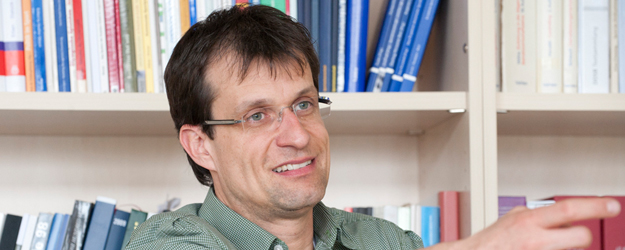5 April 2012
Sport is dear to German hearts, but before Holger Preuß conducted his study nobody had any idea just how dear it is. The professor of Sports Sociology and Sports Economics at Johannes Gutenberg University Mainz (JGU) presents figures that provide impressive proof of the economic impact of sport: Germans spend at least EUR 103 billion on sport every year.
Not that Holger Preuß will be spending much money on sport over the next few months. A meniscal tear thwarts his ski vacation. "At least it was a clean tear," says the professor of Sports Sociology and Sports Economics at the Institute of Sport at JGU. "So I might as well work during my vacation."
Preuß certainly has enough to do. One focus of his research is the economic impact of major sporting events. In fact, his diploma thesis was "The Cost-Benefit Analysis of the 2000 Olympic Games in Berlin".
Satellite account for sport
He is now working on a new project. "In the EU White Paper on Sport, all member states took up the cause of developing an accounting system that demonstrates the economic impact of sport." Preuß is now doing so on behalf of the Federal Republic of Germany. "How can we separate the impact of sport from overall economic activity and show it as a satellite account?"
Exactly this he has managed to do it with support from his colleagues and assistance from others. The paper "The Economic Significance of Sport Consumption in Germany" has just been completed. Preuß presents four charts summarizing how much Germans spend every year on sport consumption. All active sportsmen and sportswomen spend EUR 83.39 billion. "That, however, is our conservative model," explains Preuß. This model intentionally low-balls the numbers. The "realistic model" comes in at EUR 112.6 billion. This covers items such as journeys to and from sport, sports wear, sports equipment, membership fees, and medical services connected with sport.
EUR 83.39 billion for active sport consumption
Passive sport consumption is then added to active sport consumption. Passive consumption includes items such as attending a soccer match and the money spent on TV sports channels and fan articles. According to the conservative model, Germans spend EUR 19.8 billion on passive sport consumption, while the realistic model comes in as high as EUR 26 billion.
When presenting his findings, Preuß prefers to work with the conservative figures. "If people are surprised the numbers are so high, I can assure them they are probably even higher."
The huge amount of money is indeed surprising. Even if we only work with the conservative model, the total adds up to EUR 103.19 billion. "That is equivalent to between six and seven percent of overall German consumption. It is far higher than I expected." A first study was conducted in 1995, when 2,000 people were interviewed. It was updated in 2000. However, the figures were far lower than Preuß's and were generated from a much smaller basis.
Cycling is at the top of the list
The current study uses data sets from 7,031 people interviewed on the telephone; additionally, another 10,424 people were questioned about their sport consumption in an online survey. Before it could happen, however, a method had to be developed that would deliver realistic findings after the interviews. "What types of sport should we cover? Our colleagues in England included hunting while those in Spain had bull fighting on their list. We gave both a miss." Preuß and his colleagues have divided the world of sport into 71 clusters. The cycling cluster leads in active sport consumption, followed by running and swimming. Soccer comes in only sixth but is first in terms of passive consumption.
With so many figures available, Preuß could go on and on. "One in two people above the age of 16 is actively involved in sport, while for those under 16 it is two out of every three." The younger ones, however, tend to do sport in clubs, while the older ones usually do it on their own initiative.
Treasure trove of sport data
"We have a huge treasure trove of data," the sport economist is pleased to relate. "We can see what role sport plays for people with a migrant background and what kind of sport older people do. Subsequent evaluation of our data sets will deliver a wealth of interesting detail."
The German Federal Institute for Sports Science and the Federal Ministry of the Interior commissioned the study and they are primarily interested in quantifying the economic impact of sport. "But we all know that this is only one aspect of sport, and we do not want to reduce sport merely to this."
In 2011, Preuß had been involved in a study examining the significance of professional and mass sport in advertising, sponsoring, and media rights. This study revealed a total of EUR 5.5 billion. Soon, there will be a third study investigating investment in sports facilities. It was commissioned by the Federal Ministry of Economics and Technology. "When this is completed we'll have all the facts to hand", Preuß says, "and no other country will have figures as precise as ours." He can already disclose one finding: "Spending on professional sport is peanuts compared to the money spent on mass sport."
Politicians will have a lot to think about
Politicians will not be the only ones poring over the sports satellite account - the media have already expressed interest. Where should we be investing given how tight money is? "What should the government be supporting, what not?"
But that is not Preuß's problem right now. First, his meniscal tear needs to be treated. After all, the professor is keen to get back on the volleyball court and on the ski slopes. Then he can make his small contribution to the EUR 103.16 billion, too.



